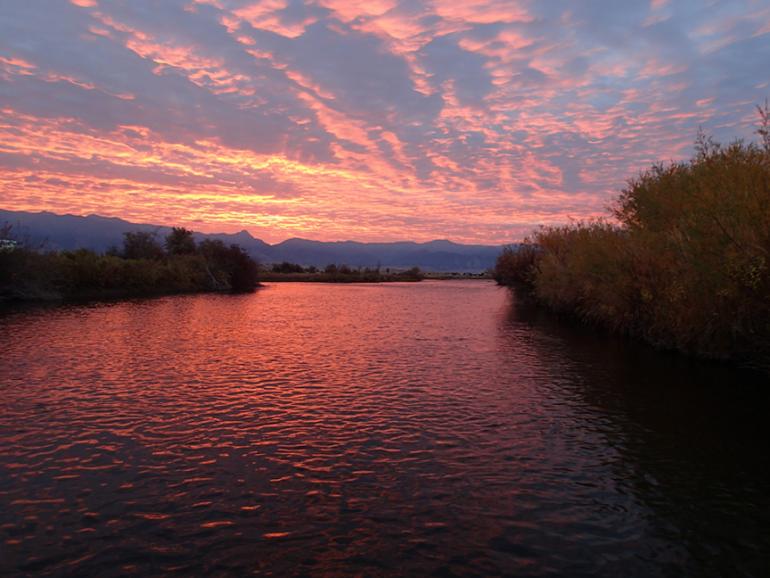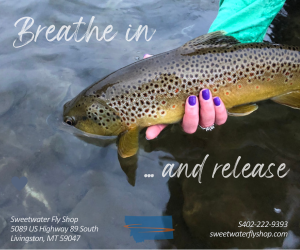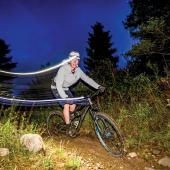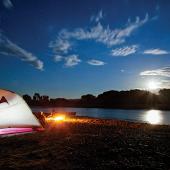Stitching Together Home
A month of Mondays on the East Gallatin.
The East Gallatin River is, by most measures, a stream of little account. Hardly anyone floats it. Only a few people fish it. From start to finish, it spans barely 25 miles, as the raven flies.
Although I’ve set a canoe into those waters a few times, it’s a mark of the river’s subtlety that it took me more than 20 years to cobble the whole length of this neighborhood flow together. It begins at the confluence of Bozeman Creek and Bear Creek, just downstream, and still in olfactory range, of the Bozeman livestock yards. It ends where it joins up with the main stem of the Gallatin River, near Horseshoe Hills. In between, it courses by such urban and suburban landmarks as the old animal shelter, the wastewater treatment plant, two golf courses, several floodplain subdivisions, and a handful of farms.
A wholly unassuming strip of water.
The East Gallatin became our spring project. Every Monday morning in May, right after we dropped the kids at school, Scott, Marypat, and I strapped canoes to roof racks, consulted the map, and indulged another two-hour stint on the little river.
Over the course of a month, we put it all together, from livestock yard to Gallatin River Ranch, the toney ranchette development that borders the end of the run. This is not a river with boat ramps and parking areas. We parked at obscure wooden bridges on ranch roads we’d never driven, at the edges of golf courses, on the gravel shoulders of secondary roads.
A sense of the surreal hovered over the endeavor. We slipped, almost surreptitiously, away from our commitments, disappeared from the radar screen of normality, only to pop back up a few hours later, dressed for work, volunteering in classrooms, attending meetings. Only the tingling memory of paddles gripped in our hands reminded us where we’d been.
On the water, the howls of dogs in back yards, the scent of cow manure and treated human waste, the call of “Fore!” from a nearby driving range, the jarring sight of lawn furniture on backyard patios—all this was juxtaposed against sandhill cranes strutting through grain fields, Canada geese nesting on gravel bars, deer crashing away in the willows, the cry of red-tailed hawks from perches in cottonwood groves, an injured white pelican paddling circles in an eddy.
The river channel itself tiptoes the balance between wild and sullied. Around one bend a toppled cottonwood blocks the entire passage, requiring a sudden stop and small portage. Around the next a length of barbed wire fence drapes dangerously from an undercut bank. There are flow-stopping beaver dams that incorporate rusted car bodies, circa 1950; blocks of concrete riprap shaded by budding pussywillow; a manicured putting green followed immediately by the unruly tumble of Bridger Creek charging in with its load of sediment from the high country.
The upper half of the drainage is a decidedly heads-up flow—tight, pushy, full of deadfall, engorged with gritty mountain runoff. The paddling is characterized by an around-the-bend tension that keeps adrenaline pumping and the atmosphere breathless.
Once, not far below the wastewater treatment plant, a snaggy tree confronted us around a tight corner, with river pushing hard through the branches, no place to pull off, and a dicey slot to duck through barely the width of a canoe. Things could go badly wrong in this watery suburbia.
In fact, the East Gallatin is a more exhilarating run, by a large margin, than many of the popular floating destinations in the area. All the more delicious because no one comes here. Not a little of the exhilaration arises out of the sense that we are sneaking one in under the noses of the neighbors, an escape with all the qualities of backcountry, disguised by the trimmings of civilization.
One Monday morning, in light drizzle, our boats cruised past a farmyard where a woman was feeding hay, wearing high rubber boots. She turned, open-mouthed, to watch us pass. We looked at each other. Nobody said a thing.
“I don’t think she believes she saw us,” Scott said, later.
This ferreting out of wildness within the grasp of development is the lesson wild things have learned. Wildlife that have no choice but to find niches within the matrix of settlement, that have found ways to survive, and even thrive, embedded in our midst.
I have found deer tracks in fresh snow on the sidewalk in front of my house, two blocks off Main Street. I’ve noticed a pile of bear scat on the edge of a road along my town bike loop. The East Gallatin is like that: a winding, riparian strip vibrating with the intensity of life, but just off the edge of vision.
Goldfinch flash yellow and black in the underbrush. Mergansers wing smoothly downstream, a foot above the current. Mink and beaver furrow the eddies. The streambank mud is stippled with the tracks of spotted sandpiper, the neat hands of raccoon, the stick-like print of great blue heron.
On the weekly sojourns we gave in to this ribbon of the untamed, where clear, spring-fed streams purl up against the turbid main flow and the insistent throb of water competes with the burbling cry of cranes, the slap of beaver tail, the high bound and flourish of deer. Like the creatures finding haven, we loosed the clutch of civilized organization, ducked behind the screen of the ordinary into this other dimension where no one would bother to look.
In July of 1806, William Clark traveled overland up the East Gallatin, on his way to what would become Bozeman Pass, and from there to the Yellowstone River. He and his small party, including Sacajawea and her infant son, rode horses through the “Valley of the Flowers,” as this country was known by natives.
Clark was putting the geography together, making observations, drawing maps, seeing country new. From his vantage in 1806, the overlay of interstate highway, cultivation, airport, and million-dollar homes would have been as inconceivable as space travel.
He found wild rose in quantity. Native lore has it that the bloom of the wild rose coincides with the flood crest on local rivers. On July 14 he noted “elk, deer, and antelope, and in every direction the roads made by buffalo…” That same day the party crossed “through an open, level plain,” remarked on the “immense quantities of beaver” in the East Gallatin, and camped at the beginning of the ascent towards the pass. Clark and his party eyed the looming range of mountains they would toil over in the morning. “In every direction the mountains are covered with great quantities” of snow, Clark wrote.
Nearly 200 years later the wild rose were in bloom, in cadence with the river’s rise towards its brief, heady crest. Beaver dams impeded the progress of canoes; the Bridger Mountains, still girded with snow, shone in the spring sun. And three pioneers escaping town devoted a month of Mondays to putting together the geography of home.











